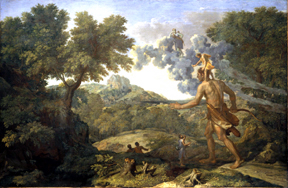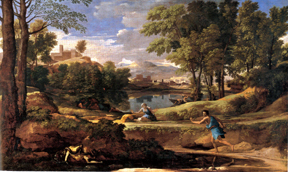
(845) 246-6944 ·
info@ArtTimesJournal.com
Nicholas
Poussin
at The Metropolitan Museum of Art
By MICHAEL X.
ROSE
ART TIMES April 2008
 Blind Orion Searching for the Rising Sun Oil on canvas; 46 7/8 x 72 in. The Metropolitan Museum of Art, New York, Fletcher Fund, 1924 (24.45.1) |
POLYPHEMUS.
ORION. Satyrs spying on the sleeping Venus. It is not every exhibition*
that showers Cyclopes, giants, and the bestial with the beautiful upon
the viewer. What an exceptional feast it is to be granted room after
room of decollations of saints, murderous serpents, blue-green corpses,
and seductive nymphs followed after by erotic goddesses, sometimes all
in the same painting!
Oh,
and I suppose any reviewer of Poussin must note that there are some
interesting landscapes holding all this together.
Rumor
has it another artist has just hung some automobiles from the ceiling
of the Guggenheim. Yawn. Perhaps that is the trouble with most Contemporary
Art, it is just so damn literal. Whether it is animals plopped in formaldehyde,
swatches of orange, sorry- saffron nylon strewn along a park's path,
or photographs of the artist's mother dying of cancer, there is no room
for myth, imagination, or the psyche to revel. Must have started with
the Art for Art's Sake/ Form Follows Function Movement, the stripping
of ornament and labeling sensual beauty as
 Landscape with a Man Killed by a Snake Oil on canvas; 47 x 78 3/8 in. National Gallery, London. Bought 1947 (NG 5763) |
What
this show has is over forty Poussin paintings gathered from Museums
and Private Collections around the world. It is a "collaborative
venture" with the Museo de Bellas Artes in Bilbao, Spain. At the
Metropolitan Museum it is organized by Keith Christiansen, Jayne Wrightsman
Curator of European Paintings, and Pierre Rosenberg, Director Emeritus
of the Musée du Louvre. And no, if you miss it, you can not fly to Bilbao
to overcome your lethargy- the show originally ran in Bilbao this past
fall of 2007. You must see this show, for many of these paintings you
will never have the opportunity to see again. They are becoming too
fragile to travel, returning to the private collections, and have such
varied and diverse locations of origin that it would require a fortune
and many years to find them all. Moscow, Copenhagen, Edinburg, Jerusalem,
Geneva, Belgium, Canada, Serbia, Sweden, Spain, and throughout all France,
Italy, England the United States, and Germany. The power of these paintings
en masse is breathtaking. One of these larger paintings was cut in half
centuries ago and scholars only recently realized that the two "halves"
formed a whole. This is only the second time the pieces have been re-united
and after the exhibit they will be separated again by Neptune, or the
Atlantic Ocean, if you will.
In
addition to this great body of paintings, there are many drawings, perhaps
fifty, that span the artist's career. They are mainly ink drawings with
washed tones for shading, and seem to be either studies for the paintings,
or "practice" sketches of landscapes and trees. Personally,
I would skip them and spend as much time absorbing the paintings as
possible.
 Spring: Adam and Eve Oil on canvas; 46 1/2 and 63 in Paris, Musée du Louvre, Département des Peintures (Inv. 7303 and 7304) |
I
do not think you curate a show of an artist of this caliber so much
as get out of their way. The work is grouped chronologically in sets
painted at the same time-period. The curators reveal a modern take on
Poussin by calling it Poussin and Nature, yet add the subtitle Arcadian
Visions. What this subtitle refers to are his complex landscapes that
are generally not real but composites of the Roman countryside, where
Poussin lived, or entirely invented. Arcadia is a rural or "bucolic"
part of Greece in the Peloponnesus, as opposed to densely populated
and more northern urban Attica where Athens lies. Arcadia was thought
to be Paradise and is the traditional home of Pan and Hermes. It is
there that you will find the River Styx. Some Greek traditions even
had it as the birthplace of Zeus. Romans drew inspiration from Arcadia
as it was the place of origin one of their founders, Evander, who pointed
out which hill the city was to be built on. Faunus, the Roman version
of the Greek god Pan, was the father of Latinus, King of the Latini,
or the Roman tribe.
This
exhibition subtitle explains then the wonderful conceptual content of
these paintings. There is no landscape of Poussin's that is lacking
a human presence (I do include fauns, Satyrs, centaurs, God, and angels).
A "pure" landscape is a theatrical stage on which there are
no actors. No Will, no Fortuna, no story. That kind of painting is for
me utterly unsatisfying.
The
curators have done a fine job of getting out of our way.
I
include here a quote from Cézanne provided by Pierre Rosenberg. "I
would like, as in the Triumph of Flora, to join the curves of the women
to the shoulders of the hills…Like Poussin, I would like to put Reason
in the grass and tears in the sky." Though Cézanne often omitted
characters from his paintings, leaving them vacant, I would agree. Poussin
was attempting to do the opposite of Andy Warhol, who made art to please
the crowds. Warhol's art was meant to be looked at for 15 minutes. Poussin's
paintings are meant to be contemplated, meditated long on, and read
like an epic poem or a passage from the Bible. You are able to spend
15 hours initially imbibing, then fifteen years. Naturally, Formally,
and Conceptually, the glasses are all full. Each individual painting
is fully complete in itself, the exhibition could comprise only one
work and be omnisatiating.
 Landscape with Orpheus and Eurydice Oil on canvas; 48 7/8 x 78 3/4 in Paris, Musée du Louvre, Département des Peintures (Inv. 7307) |
Hopefully, I do see a return to this conceptually in Painting. Perhaps it first sprang from the Outsider Art, Primitive Art, and Folk Traditions so popular 15 years ago, but many fresh shows in smaller new galleries are exhibiting work with a longer shelf life. But the Big Box Stores, i.e. Contemporary Art Museums, remain caught in a P.T. Barnum-like race to shock and awe the masses, however briefly. Think of all the labor, time, and money that went to hang Cai Guo-Qiang cars from the ceiling. There is no Formal angle, no Natural reference. Just a pun on gravity. And you get it in an instant, a moment later the thrill is gone. It is, in the second glance, so ultimately boring.
Modernist
Manifestoes at the turn of the last century called for burning libraries
and blowing up museums. Sometimes I wonder if they didn't succeed too
well, but used a kind of Neutron Bomb, where all the buildings are intact
but all the people (i.e. the new artwork produced by them inside) are
dead.
Are
Contemporary Art Casinos Narcissus gazing at his own reflection, in
love with himself, 'til he pines away and dies, famished and unfulfilled?
The thought crossed my mind when reflecting on Nicholas Poussin's painting,
The Infant Bacchus Entrusted to the Nymphs of Nysa; the Death of Echo
and Narcissus.
(Michael X. Rose, michaelxrose.com, is an artist and painter who lives, works, and shows in the Hudson Valley Area)
*“Poussin and Nature: Arcadian Visions” (thru May 11): The Metropolitan Museum of Art, 1000 5th Ave., NYC. (212) 879-5500. A full-color catalogue (Yale University Press: 432 pp.; 8 ¼ x 11; 242 Illus., 232 in Color; Bibliography; Index of works by Poussin; Index. 65.00 Hardcover) accompanies this exhibition.